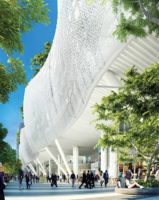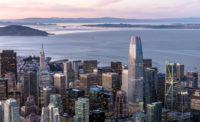A grand act of place making, San Francisco’s just-opened Salesforce Transit Center elevates an oft-mundane building type—a mass transit station—with a 5.4-acre public park, one of the largest accessible green roofs in the country. The 1.2 million-square-foot center, designed by Pelli Clarke Pelli Architects, helps to assert a new identity for the city, as a metropolis of distinctly contemporary density and form. It also presents an alluring vision of a sustainable future. But with some key functionality missing, it must wait to fulfill its larger mission.
Additional Content:
Jump to credits & specifications
Conceived as the “Grand Central Station of the West,” the nearly $2.3 billion project has been more than 10 years in the making, a saga of funding problems, budget overruns, political scuffles, and delays of the kind that seem to bedevil all large public infrastructure projects in the U.S. Back in 2005, city officials approved a plan to redevelop what they dubbed the Transbay District—a rundown 40-acre area to the south of the city’s financial center where a now-demolished freeway and ramps once cut through. The plan embodied the latest thinking in urban-planning circles: a transit hub that would replace a dilapidated Depression-era bus station and connect to commuter and high-speed rail, surrounded by a dense, mixed-use, mixed-income (35 percent of the planned 4,400 housing units are designated as affordable) development. Land sales, along with developer fees and taxes for an adjacent tower, the tallest in the city, and other high-rises, would provide a substantial portion of the funding for the public terminal.
In 2007, the developer-architect team of Hines and Pelli Clarke Pelli won the competition for the station and a skyscraper (named Salesforce Tower for its lead tenant) with a proposal for a greensward in the sky. But this vision was more than romantic—it was practical too: in addition to being a public amenity, the transit-center park would provide other long-term benefits, including energy management and water conservation, says Fred Clarke, senior principal at Pelli Clarke Pelli.
Despite some nail-biting moments during the recession, the completed project is remarkably unchanged from the competition-winning scheme. The four-block-long layer cake has two levels below grade, with train platforms at the bottom for future commuter and high-speed rail, and a train-concourse level. Aboveground are two floors of concourse and retail space, topped by the bus deck—which had to be elevated to connect to the freeway leading to the Bay Bridge—and then the rooftop park.
One significant change is not necessarily for the worse. The original scheme included undulating glass facades, bulging out where columns inclined outward to support the cantilevered bus deck. But the curved glass would have to have been very thick to meet blast requirements and consequently proved too expensive. Instead, the project team wrapped the building with a white aluminum screen, perforated with an intricate pattern devised by mathematician Roger Penrose, a nonrepeating kaleidoscope that maps elegantly to the irregular curves. The gauzy screen effectively veils the station’s heft and creates a delicate backdrop for the bus level within. “The cloudlike exterior makes the building look as though it floats,” says Clarke. “It’s that kind of civility and friendliness we were after.”
The double-height main hall, which occupies about a quarter of the ground floor, celebrates daylight and engineering. Here, a generous skylight is supported by a sculpture of steel columns that curve out to the edges of the 65-by-85-foot elliptical roof opening. It beams sunlight down on a bank of escalators, making wayfinding to the bus deck and the park intuitive. The profusion of white and reflective surfaces, from columns to the metal ceiling to a terrazzo floor that features a colorful design by artist Julie Chang, amplify the light and feeling of openness. (Salesforce’s purchase of the station’s naming rights for $110 million over 25 years will go toward the building’s upkeep, helping to maintain its pristine and airy atmosphere.)
Designed by PWP Landscape Architects, the park is a rolling landscape that cleverly integrates exit stairs, elevator overruns, and mechanical vents amid its hillocks and more than 600 trees, including redwoods and palms. A half-mile loop trail passes a restaurant, playground, amphitheater, and a water fountain by artist Ned Kahn with a row of jets that fire up as buses pass below. In addition, it offers views of the cityscape à la New York’s High Line. An infusion of open space into an area bereft of parks, the living roof is also a critical part of the center’s operations, helping mitigate heat gain and incorporating wetlands that filter rainwater and graywater for non-potable uses. The green roof, along with such features as the naturally ventilated bus deck and a geothermal loop for conditioning the enclosed spaces, is projected to cut energy use in half compared to the requirements of California’s stringent energy code.
As wonderfully verdant as it is, it remains to be seen whether the park, located 75 feet above the street, will become a bustling part of city life or whether it will function more like a private garden for the adjacent office and apartment buildings that bridge directly to it. Unlike the High Line, the park doesn’t serve as a handy path from point A to point B, and, to get to it, visitors will have to take a small gondola, one of several street-level elevators or escalators, or reach it from inside the terminal or a neighboring building.
Another question is if or when the facility will be a full-fledged multimodal transit center, which presumably will be needed for the center’s retailers to truly flourish (about half of the 100,000 square feet of retail has been leased, with the first store openings expected next year). For the foreseeable future, the station will handle an average of 37,000 bus commuters on weekdays, though it has been designed in anticipation of 100,000 travelers. One major challenge is to secure a daunting $4 billion to build a 1.3-mile tunnel to connect to an existing Caltrain commuter-rail station and the long-planned high-speed rail to Los Angeles (itself far from a done deal). A pedestrian tunnel that would link to Bay Area Rapid Transit (BART) trains is also planned but also has yet to be funded. But the hub itself and its rooftop oasis are finally here to welcome all these potential users, and that should gladden the hearts of urbanists everywhere.
Salesforce Transit Center from steelblue on Vimeo.
CreditsArchitect: Pelli Clarke Pelli Architects, 1056 Chapel Street, New Haven, CT, 203.777.2515, pcparch.com
Personnel in architect's firm who should receive special credit: Cesar Pelli, FAIA, RIBA, JIA, Fred W. Clarke, FAIA, RIBA, JIA, Mark Shoemaker, AIA, Randy Volenec, RA, Heather Kim, RA
Architect of record: Adamson Associates International Inc., 700 S. Flower Streeet, Suite 860, Los Angeles, CA 90017, 310.230.0088
Engineers: Structural: Thornton Tomasetti Specialty Structural: Schlaich Bergermann Partner MEP/IT: WSP Specialty MEP: BuroHappold Geotechnical and other Engineering Services: Arup
Consultants: Landscape Architecture: PWP Landscape Architecture Sustainability Design: Atelier Ten Land Use/Environmental: Rana Creek AV, IT, Security, Acoustics: Shen Milsom & Wilke Curtain Wall/Façade Design: Vidaris Environmental Graphics: WRNS Studio Building Maintenance: Lerch Bates & Associates, Inc. Cost Consulting: AECOM Lighting Design: Auerbach Glasow Mechanical Controls: HMA Consulting LEED Administration: IES Accessibility Consulting: McGuire Associates Vertical Transportation: Edgett Williams Consulting Group Waterproofing Consulting: Henshell & Buccellato Wind Tunnel Testing: RWDI Vibration Consulting: Wilson Ihrig & Associates Emergency Communications: Jensen Hughes Fountain Consulting: Fountain Source Architecture for the Blind: Chris Downey Architect Retail Consultant: Brand + Allen Architects Artist: James Carpenter Artist: Julie Chang Artist: Jenny Holzer Artist: Ned Kahn
General contractor: Webcor/Obayashi Joint Venture
Photographers: Tim Griffith, Jason O'Rear |
SpecificationsStructural system Cast Steel Nodes: CAST CONNEX, Bradken Engineered Products Structural Steel Sections and Pipes: Oregon Iron Works
Exterior cladding Metal Awning Perforated Panels: ASI Metal Awning Space Frame: DSI Space Frames Metal Awning Patch Plates: Nupress Group Metal/glass curtain wall: Gardner Metal Systems (GMS) Metal panels: ASI / Keith Panel Systems Co. Ltd (KPS) Metal panel siding: Centria Trellis: Greenscreen Bird Control: Bird Barrier America / Bird B Gone Moisture barrier: Best / GCP Terracotta: Boston Valley TerraCotta Plaster: LaHabra Metal Column Covers: BEST Metal Louvers: Construction Specialists Ballastic Glass System: U.S. Bullet Proofing
Roofing Built-up roofing: Best/Grace Intensive Green Roofing: Sarnafil PVC Roofing: Sarnafil Roof Railings: Olson Steel
Glazing Glass: Viracon Skylights/Grid Shells: Nupress Facades Fire Rated Glass Floor: Greenlite / Vetrotech Ballastic Glass: Patriot Armor Plastic glazing: 3Form
Doors Glass doors: CRL (C.R. Laurence Co) US Aluminum Sliding doors: Record Security grilles: McKendry DoorSliding doors
Hardware Closers: Rixon, LCN Exit devices: Von Duprin, WIKK Pulls: CRL Security devices: Advanced Control Devices, Command Access
Interior finishes Acoustical ceilings: Armstrong Suspension grid: Armstrong Operable partitions: Hufcor Plastic laminate: Formica Solid surfacing: Cambria Floor and wall tile: Creative Materials Carpet: Julie Industries, Inc. Raised flooring: Tate Access Floors, Inc. Terrazzo: Associated Terrazzo Metal Ceilings: Gordon Metals Environmental Graphics Signage: Architectural Design & Signs Stainless Steel Handrails: HDI
Furnishings Fixed seating: Zoeftig Ltd Illuminated seating: 3form
Site Art Paving: TB Pennick Custom Planters: Universal Precast
Park Paving: Natural Pave Custom Wood Furnishings: Blank and Cables, Oakland, CA Cafe Chairs: Bertoia Side Back Chair Café Table: West Coast Industries Play Equipment: Landscape Structures Play Surfacing: PebbleFlex Rubber Surfacing Site Stone Masonry: Quarry SE, Seattle, WA / Coldspring Granite Art Fountain Glass: Progress Glass
Lighting Exterior lighting: Bega, BK lighting, BOCA Flasher, Insight lighting Interior ambient lighting: Insight lighting, Elliptipar Downlights: Gotham Specialty lighting: Lumen Pulse, SPI Lighting, A light Dimming system or other lighting controls: Lutron Custom Art Light Fixtures: (Jamie Carpenter) 3Form Large Fan Light Enclosures: 3Form
Conveyance Elevators: Otis Escalators: Schindler
Plumbing Toilet partitions: Bradley Restroom accessories: Bobrick / ASI Hand dryers: Excel Dryer Inc
Energy Geothermal Loop: S3H Large Ceiling Fans: MacroAir |









Post a comment to this article
Report Abusive Comment